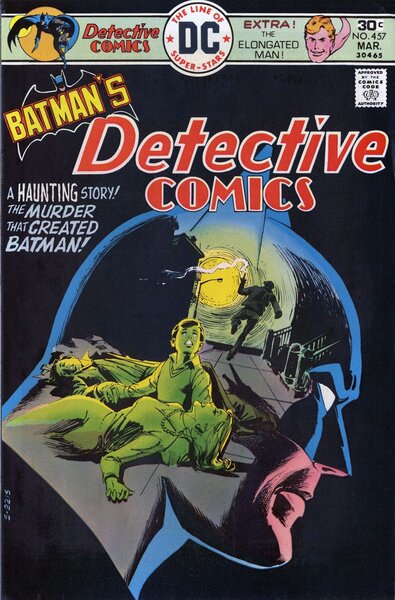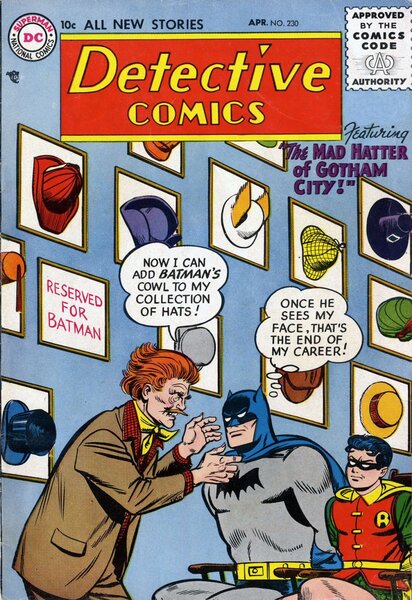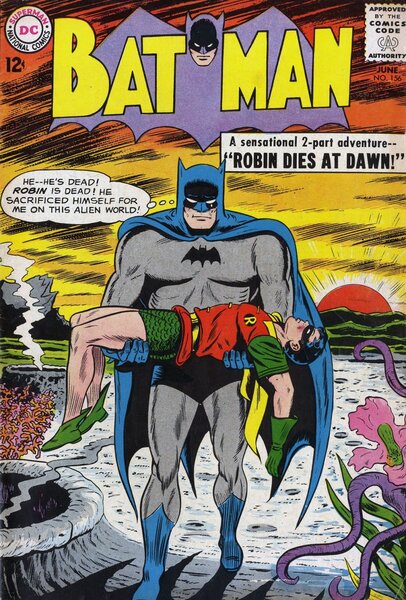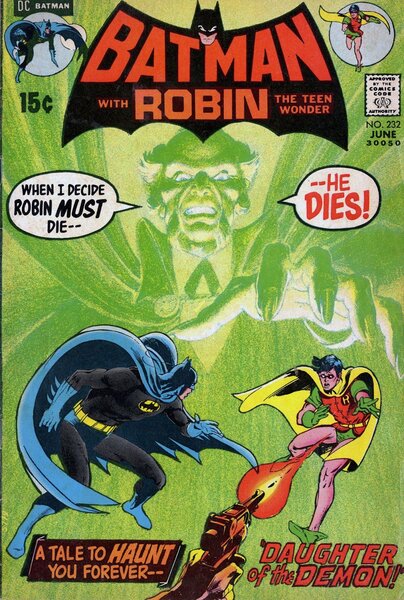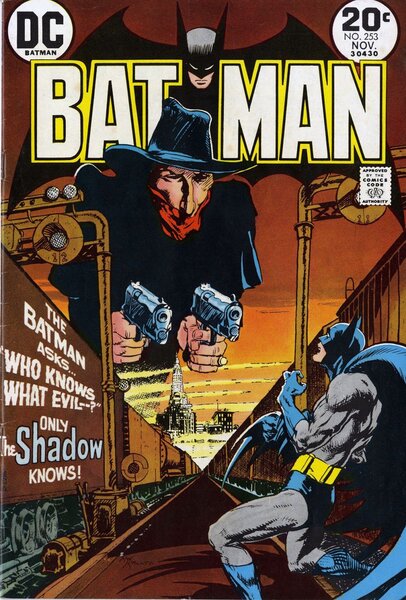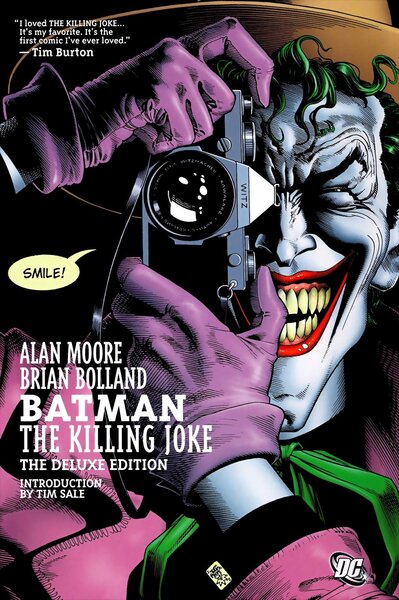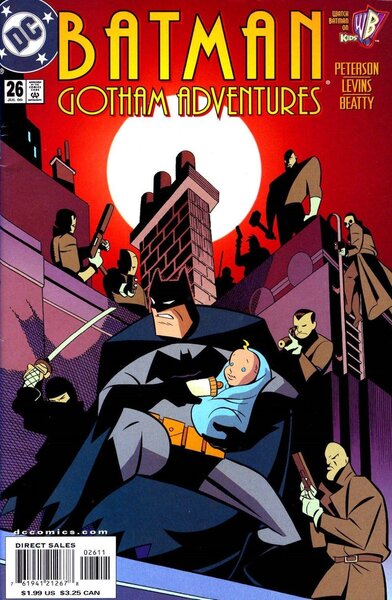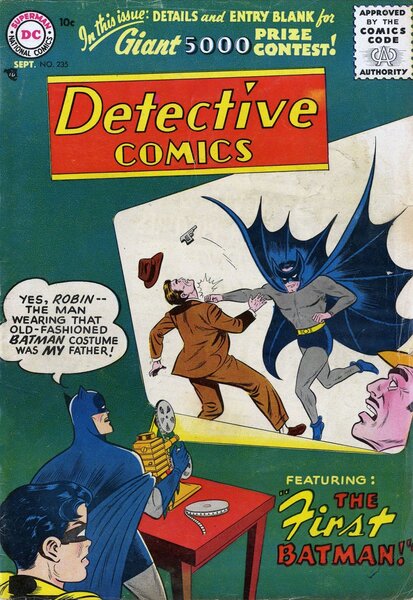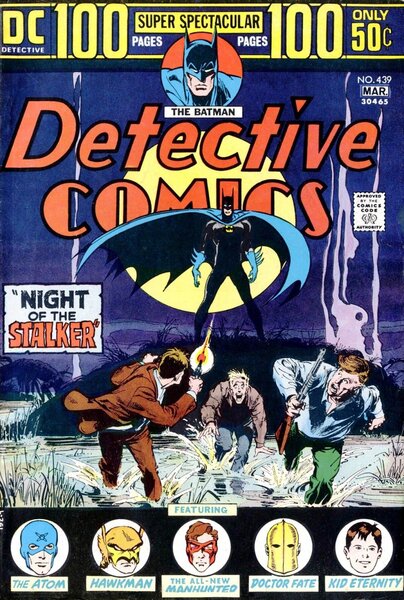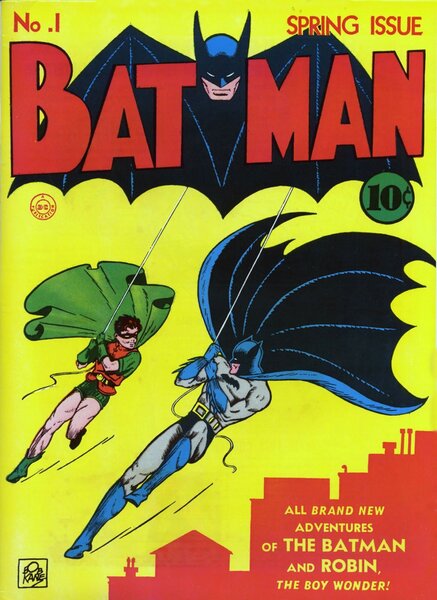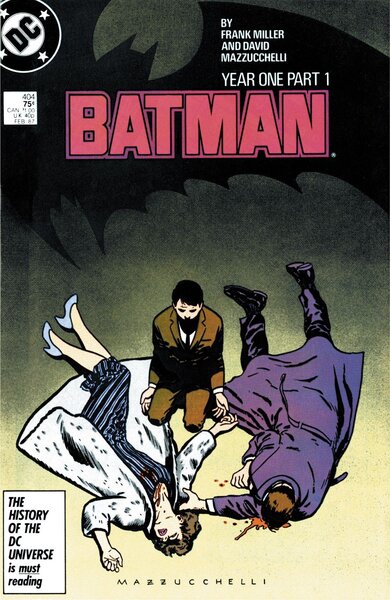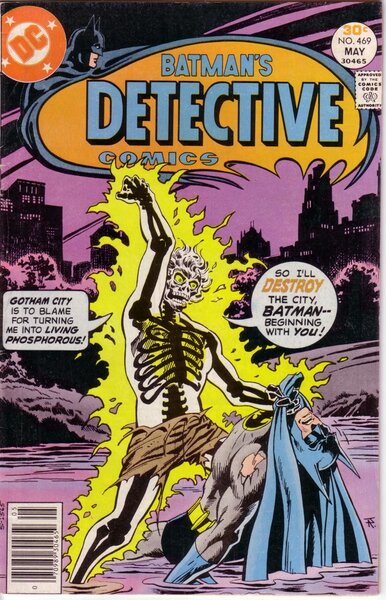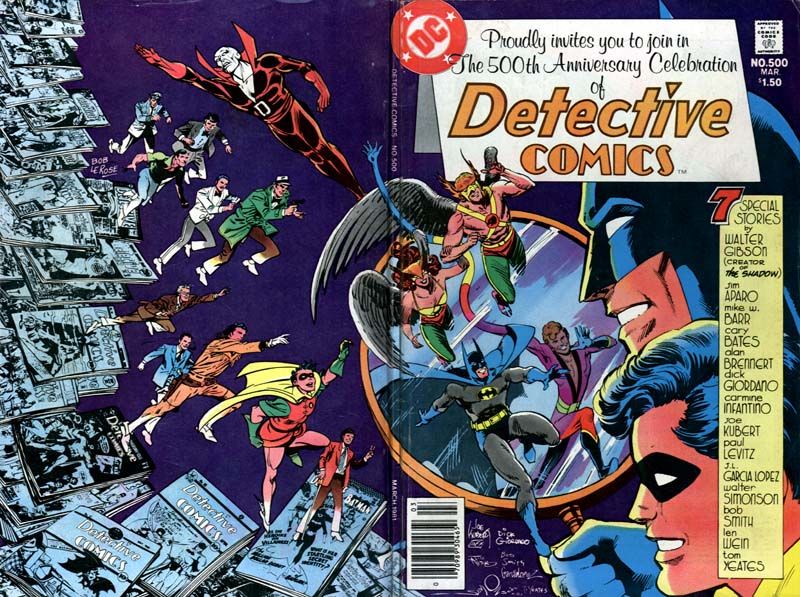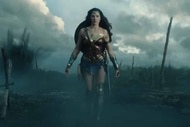Create a free profile to get unlimited access to exclusive videos, sweepstakes, and more!
DC writers and artists reveal their favorite Batman comic book stories
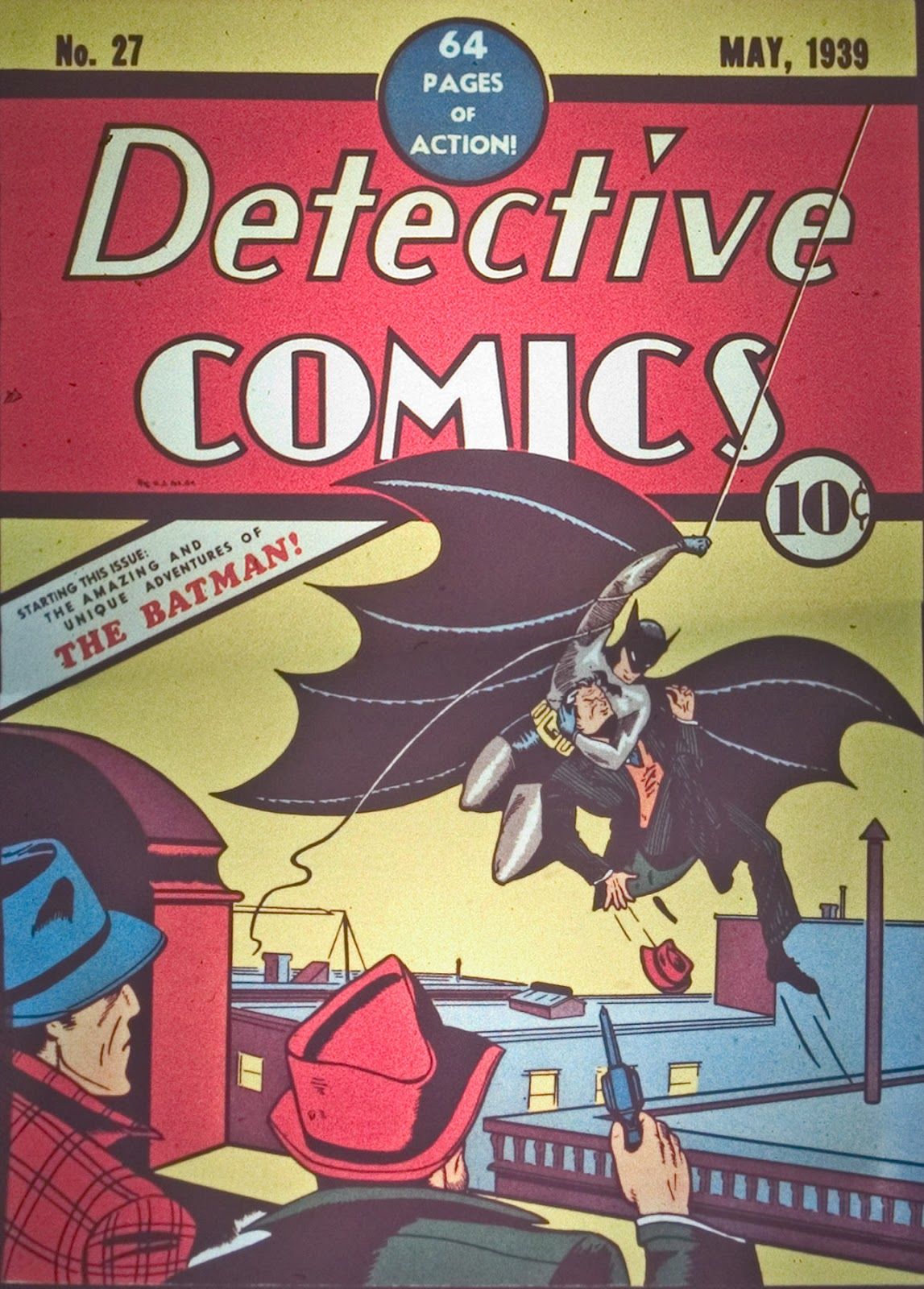
If you ask longtime DC Comics editor, writer, and creator Paul Levitz, the magic of Batman lies in the many different interpretations of the Dark Knight through the years. In the pages of thousands of comic books, on the big screen in live-action films, in a video game on your phone, Batman has been through countless adventures.
"So many of us see him differently, and bring him to life that way," Levitz told SYFY WIRE. "The ability of Denny [O'Neil], Frank [Miller], Neal [Adams] ... so many others in comics, and Tim Burton and Chris Nolan in film, to each see different aspects of the character is wonderful."
With so many Batman stories and arcs to pick from, Batman fans can always debate on which is the best, but what about your first experience with the Caped Crusader? Everyone, from fans to the most famous creators, has a first time they saw Bruce Wayne in the Batcave, a first time they saw him don the cape and cowl, the first time they saw him face the Joker. Everyone has a first Batman comic book.
We asked more than a dozen Batman creators about their first and/or favorite Batman issue and to explain why it left a mark on them. The only rule? They couldn't pick something they worked on directly.
For Levitz that was a problem, because he worked so closely on so many Batman titles during his tenure at DC.
"Two stories I definitely didn't touch were 'There's No Hope in Crime Alley,' when Denny added a lovely human dimension to the Wayne tragedy, and 'The Batman Nobody Knows,' written by Frank Robbins, both drawn by Dick Giordano," Levitz said. "The latter story just felt very simple and human."
As for his first time seeing Batman in the pages of DC Comics, Levitz said it probably happened in 1963.
"I might have come in at Detective Comics #319 or thereabouts. An older kid on my block had a box of comics, and it included a few issues from around that moment," he said. "I smile looking at the cover, kinda dopey as it is by modern standards, but it takes me back to the drama of the mountainside battle."
Here's what other storytellers recalled of their first times reading about Batman:
Steve Englehart
Batman, The Batman Chronicles, Batman: Dark Detective, Batman: Legends of the Dark Knight, Detective Comics
The most significant issues for me begin with Detective Comics #230, from April 1956, because it's the first time I ever saw Batman. The art was typical "Bob Kane" stuff from the mid-'50s, but the story was the first appearance of the Mad Hatter — which introduced me to Batman's world of weird villains at the same time it intro'd me to Batman. Even with the lame art, there was something operatic about the concept.
But that very same month, we had Batman #99 with "The Phantom of the Bat-Cave." This was another side of Batman, who faced a seemingly impossible locked-room crime and solved it through scientific knowledge. That was not what Superman did. And since it was the whole Batman comic, there was also a Penguin story and a story about Batman doing time travel, which he apparently did quite often — all three with Bob Kane art. Bob Kane art was bad but distinctive, and distinctive was interesting.
Please remember that this was 1956, between the Golden and the Silver Age, and basically what we had for superheroes was Superman, Batman, and Wonder Woman. That's it. And this Batman guy promised to be a whole lot more interesting than the other two did. Wherever I ended up with the Batman, after filtering him through my developing mind for the next two decades, it started with these two books.
A reminder you hear from time to time is "It's always somebody's first issue." These were mine.
Peter Milligan
Detective Comics, Batman Confidential, Legends of the Dark Knight and The Resurrection of Ra's al Ghul
Not so much for its quality – it was a pretty insane story of dubious merit – but for the place it has in my memory, one Batman issue I remember is "Robin Dies at Dawn."
I was in the hospital when it found its way to me. I had a "mystery illness," which itself sounds like something from Silver Age comics. I'd go a day or two feeling okay and then lapse into fever and near-delirium. It was during one of my okay periods that one of the nurses handed me a few old comics she'd grabbed from the bunch of comics and books in the children's ward. One of these was "Robin Dies at Dawn," written by Bill Finger, with art by [Charles] Paris and [Sheldon] Moldorf.
Two things struck me about the comic. First: the over-the-top cover, showing a weeping Batman holding a dead Robin. Second: Even as a kid I was aware of how magnificently inappropriate it was to give a young patient who for all he knew was going to die, if not at dawn then soon after, a comic like this. Even so, maybe due to my groggy state I really got into the insane tale of the alien world and the gorilla gang. I slipped into one of my fever states before I got to the end of the comic. When I came round, the comic had gone, passed on to some other unwell youngster. So I didn't know how it ended.
"Turns out both Robin and me survived!!"
Larry Hama
Batman, Batman: Legends of the Dark Knight, Batman: Shadow of the Bat, Batman: Toyman
Dick Sprang's work on the Golden Age Batman was the first that caught my eye as a kid, but there weren't really "arcs" back then. The three Batman arcs that stand out to me are the Denny O'Neil/Neal Adams run, Frank Miller's Dark Knight, and David Mazzucchelli's Batman: Year One."
Will Murray
The Further Adventures of Batman
Two of the most consequential Batman stories ever published were crossovers. It's well known that the first Batman story was an adaptation of a 1936 pulp novel featuring the Shadow, Partners of Peril. Consequently, Batman is literally a comic book version of the great pulp hero. Both were millionaires who fought bizarre bad guys and hobnobbed with the resident police commissioner. Bill Finger, who wrote that initial Batman story, admitted that his first Batman tale was a "take-off" of a Shadow novel. "Take-off" is a polite way of saying "unauthorized adaptation."
As for artist Bob Kane, he once admitted, "I suppose both the Shadow's cloaked costume and the double-identity role, as well as the extraordinary acrobatics of Douglas Fairbanks Sr., did more to my subconscious to create the character and personality of Batman than any other factors." Fairbanks had played an earlier ebony-cloaked hero, Zorro, so here Kane is confessing that Batman is a combination of Zorro and the Shadow.
The two 1930s caped crusaders probably would never have met — after all, they were rivals when both had their own comic books in the 1940s — but in the 1970s DC Comics acquired the rights to The Shadow and launched its famed Shadow title, initially drawn by Mike Kaluta. License in hand, DC decided that the two former rivals should meet, if only for cross-promotional purposes. They crossed paths in the pages of Batman #253, November 1973.
With an eye to the parallel history of both characters, scripter Denny O'Neill came up with an intriguing approach. Since The Shadow was set in the '30s and '40s, and Batman continued to evolve beyond his original timeframe, he set up a story titled "Who Knows What Evil––?" wherein they are framed as belonging to two different generations of heroes. Out west in a place called Tumbleweed Crossing, Bruce Wayne is tracking a counterfeiting ring, with an assist from a shadowy and mysterious figure he never clearly sees. Since this is a Batman story first and foremost, it's told from his point of view. Even when the Shadow sticks in finger in, he never reveals himself. But Batman suspects the truth.
Artist Irv Novick kept the Shadow out of the desert sunlight until the climax, which was the best part of the story. Returning to Gotham City, Batman and the Shadow meet face to face. There, the Shadow compliments the Dark Knight on a successful crime-fighting career and essentially gives his blessing.
"I consider that a magnificent compliment!" responds Batman. "I've never told anyone this … but you were my greatest inspiration … I'd be honored to shake your hand!"
"The honor is mine!" returns the Shadow as the two crimefighters shake hands. Exit the Shadow, laughing, presumably with satisfaction.
A year later, for Batman #259, O'Neill and Novick repeat their magic in "Night of the Shadow." Again, O'Neill is playing off established Batman backstory. In his earliest adventures, the Caped Crusader carried a solitary automatic. After one particularly cold-blooded episode in Detective Comics #32, DC ordered Finger and Kane to cease and desist depicting Batman toting a gun. They complied.
Kane later noted, "We didn't think there was anything wrong with Batman carrying a gun because the Shadow used one."
In the comics, it was never explained why the character abandoned his automatic forever — until Denny O'Neill got around to explaining it some three decades later. Between those two tales, we learn more about Batman's motivations and his approach to crime-busting than in any other hundred stories. And that's why they're so significant.
Had DC's Shadow comic continued into a third year, no doubt these two crimefighters would have met again. And I would today be writing about a trilogy of consequential stories. One can only speculate what O'Neill might have done in a third go-round. But I seem to hear the Joker's laugh being drowned out by that of another …
And I can only wonder what The Shadow creator, Walter B. Gibson, would have said of all this. He once derided Batman as a "clowned-up version of the Shadow." Yet after The Shadow Magazine folded in 1949, Gibson drifted into comic books and scripted a handful of Batman stories. One of his last short stories also starred Batman. Gibson wrote "The Batman Encounters Gray Face" so that if the opportunity ever arose, he could just change the names of the characters and it would become another Shadow story, indistinguishable from all others.
That's how conceptually close these two characters are. And why those historic crossovers stand out from the torrent of Batman stories written over the last eighty years …
Ron Marz
Batman Saga, Batman Villains Secret Files, Batman/Aliens. Batman: Hidden Treasures, Batman/Tarzan, Legend of the Dark Knight
I think there are more great stories with Batman than any other comic character. For me, it's a trio that all came out in the same era: The Dark Knight Returns by [Frank] Miller and [Klaus] Janson, Batman: Year One by Miller and [David] Mazzucchelli, and The Killing Joke by [Alan] Moore and [Brian] Bolland. They all came out when I was rediscovering comics, and eventually pointing myself to a career in comics, so all of them were hugely influential on me. Each is a fairly different take on Batman: Rookie Batman, Batman in his prime, and a grizzled Batman. But the writing and art on each is superlative, and each showed me the possibilities inherent in comics as a storytelling medium. Dark Knight Returns especially was like a bolt from the blue. The format, the story, everything blew me away. I re-read all of them at least once a year.
Devin Grayson
Batman: Gotham Knights, Batman/Joker: Switch, Nightwing and Huntress
My favorite Batman stories are the ones that strike a balance between his mythological status and his humanity, and I think that's often demonstrated most effectively in the comics that are deliberately made accessible to kids. A great example is Batman: Gotham Adventures #26 by Scott Peterson and Tim Levins.
The story, "In Arms," has a mystery he's solving as a detective, plenty of action, suspense, and humor, a great example of the extent to which his reputation precedes him and how he uses that to his advantage, a lovely acknowledgment of his connection to Alfred, and multiple illustrations of his compassion—all while he's carrying a baby around, Lone Wolf and Cub-style.
There are probably more succinct ways of demonstrating who Batman is than showing him protecting a baby's life in increasingly hazardous situations while also holding it wrong, but I'm not sure there are better ones. One of his defining qualities for me has always been the extent to which he's had to sacrifice aspects of normal human development in order to become as extraordinary as he is. This story shows that very clearly while also underscoring how his decision to do things that way, while sometimes problematic, is unquestionably heroic."
Jerry Ordway
Batman Annual, Batman: The Official Comic Adaptation
During the early 1960s, I recall reading a Batman or Detective Comics Annual which had a reprint of an older story where Batman tells of the Bat-costume in the Batcave that his father wore. Bruce Wayne's father dressed as a Batman? It was a kind of mind-blowing concept to me as a little kid, that Bruce was kind of following in his father's footsteps. It's a cute story, and one that inspired me to write a similarly themed story for the comic Power of Shazam, where Billy Batson is in an alternate world where his father and mother not only still lived, but had become superheroes!
In the 1970s, I was pretty much a Marvel fan, but had drifted to DC Comics to follow Jack Kirby's New Gods stuff. At one point, I subscribed to eight DC comics through a subscription offer, and added the Batman comic to fill out the order. Later, in the mail I got this great Batman/Two-Face story, done by Denny O'Neill and Neal Adams! Wow, I was blown away by that. It was Issue #234, and in the issue, Batman is at the mercy of Two-Face, tied to a sinking ship, about to drown. Two-Face flips his coin, and it lands with the unscarred face-up. He then has to save Batman! I just thought that was a great and different story, and Batman could not have looked cooler, his cape fanning sleekly behind him! Neal and Denny became my favorite Batman creators.
A few years later, Steve Englehart, Marshall Rogers, and Terry Austin changed things up again, with their short run on Detective Comics, with Englehart starting as writer on Issue #469, and Marshall Rogers joining as penciller on Issue #471. It was great stuff, and their Joker story was really memorable. The series re-introduced some long-forgotten villains and added a new love interest, Silver St. Cloud, who figured out Bruce Wayne was Batman. Wow, just a nice combination of good story and great moody art.
As a young child of 8, I was a huge fan of the 1966 Batman TV show, but then by age 10 I had left it behind for the more adult (a 10-year-old's version of "adult" ) Marvel Comics heroes. I lost interest in Batman for a few years until seeing that Two-Face story, and then began following Batman and Detective Comics again.
There was some really good stuff being done in Detective Comics prior to the Englehart/Rogers/Austin era, when Archie Goodwin took over as editor in maybe 1973. Batman as a character, I think, often brings the best out in creators. With so many great renditions of Batman, the competitive spirit forces folks to try to top these stories they read as fans, you know?
Gail Simone
JLA: Classifield, Birds of Prey, Batgirl
My favorite Batman story isn’t flashy or even particularly well-known. But it has forever shaped my vision of Batman. It was in a 100 Page Special I found at a garage sale as a kid. We were poor, I had no access to a comics store, so I would buy them every chance I got. The story is "Night of the Stalker," from Detective Comics #439. And it’s interesting, because Batman never speaks in the entire story.
"Batman witnesses a senseless crime, almost identical to the one that ended with his parents’ death. And something breaks in him, temporarily. He chases the shooters, silently and relentlessly. He terrifies them, and it’s no act, he’s just genuinely become this creature of the night that he’s always sort of played at being. And the last moment, when he faces a portrait of his parents with his cowl down, just broke my little kid heart.
"It’s written by the great Steve Englehart and sensitively drawn by the terribly under-rated Sal Amendola; at times it feels like an Orson Welles film, all shadow and portent. But to this day, I find it the best version of a cautionary version of Batman, a Batman who goes too far. And it reminds me that Batman who acts like Wolverine isn’t really Batman at all."
Michael Uslan
The Boy Who Loved Batman
[My favorite is] Batman #1, because not only was Robin brand new, but this issue introduced both the Joker and Catwoman, elevating the mythology of Batman to a new level. [In second place,] Denny O'Neil and Neal Adams introducing Ra's al Ghul, Talia, and the League of Assassins. This arc truly redefined Batman' return to darkness in the comics post the Batman TV series.
[Finally,] "Night of the Stalker" from Detective Comics #439 brought Bruce Wayne back to the beginning of his nightmare and took the readers along for the emotional, gut-wrenching experience, confirming just how human Batman is and why he must do what he does.
Becky Cloonan
Batman, Detective Comics
Batman: Year One by Frank Miller and David Mazzucchelli, which is, in my opinion, a near-perfect comic. The story has been retold so many times since then that if you're just now reading it for the first time it might be hard to see what was so innovative about it, but the modern Batman — the gritty detective as we know him today, and his relationship with the hard-boiled Gordon — really feels like it started here.
Mazzucchelli's art is sublime. For me, he's the real star here. Every page is like a noir film come to life! His lines are loose yet deliberate, balancing the detail against stark black and white with seemingly effortless ease. He manages to create art that is at the same time iconic and emotive, and no matter how long I look at the pages I always find something new to marvel at.
Year One is a short book, but it packs a whopper of a punch. If you haven't read it, do yourself a favor and pick it up. For me, this is where it all begins.
Jordan B. Gorfinkel
Batman: No Man's Land, The Batman Chronicles, Batman: Knightfall, Detective Comics, Batman: No Man's Land Secret Files
I'm trying to recall the name of the story. Pretty sure Denny O'Neil wrote it. Short Batman story, Bruce Wayne with kids around a campfire, everyone relating their impression of the Batman. *Spoiler Alert* At the end Bruce leaps out wearing his Batman costume and the kids think it's weak. Meaningful to me because it encapsulates everything that's great about the Batman character and story potential: There's a Batman for every generation, genre, background … he's an endlessly adaptable myth, and that's the key to his longevity. And the point is made in a most entertaining, surprising, suspenseful, and humorous story. And I love campfires.
J.M. DeMatteis
Batman & Spider-Man: New Age Dawning, Batman: Absolution, Batman: Legends of the Dark Knight, Batman: Two-Face - Crime and Punishment, Detective Comics
One of my primal memories is being 6 or 7 years old, sprawled out on the living room floor with crayons and a stack of drawing paper, trying to replicate a Dick Sprang/Sheldon Moldoff-era Batman cover line for line. In many ways, that square-jawed, slightly goofy (okay, more than slightly) version of Bats is the one I cherish more than any other. And there's no story that had more impact on my young, impressionable consciousness than "Robin Dies at Dawn" in Batman #156, which features one of the greatest covers in the character's history.
The entire story turns out to be a cheat — a hallucination resulting from Batman's participation in a government-run isolation experiment — but it had a massive impact on me nonetheless. Until that final reveal, Little Me truly believed that Robin had died and I was both astonished and grief-stricken. I've never forgotten that story or that haunting cover image.
Looking at more modern Batman tales, it doesn't get any better than the classic Steve Englehart-Marshall Rogers run. Batman is very much the Dark Knight, but he's also fully human. The villains are written to perfection and the stories are filled with adventure, imagination, and heart.
Scott M. Beatty
Batman: Gotham Knights, Batman Begins: The Visual Guide, The Batman Handbook: The Ultimate Training Manual, Batman: The Ultimate Guide to the Dark Knight
I can't think of a harder task than to narrow down my favorite Batman stories. My "favorites" are countless one-and-done issues, entire runs, and even the most obscure groan-inducing Silver Age tales with the Dark Knight foiling alien invaders or being forced to wear embarrassing variants of his cape and cowl ... stories that today seem antithetical to our shared cultural experience of who Batman is.
Most Batman scholars would argue that he's ALL of that, and I can't disagree. Personally, I went for the "low-hanging fruit" here, stories that I read as a kid that helped define Batman for me in my formative years as a Bat-Fanboy. First up is Alan Brennert's and Dick Giordano's "To Kill a Legend" from Detective Comics #500, which I suppose is appropriate since we're careening toward the landmark 1,000th issue of Detective Comics. That, in and of itself, makes me feel desperately old.
"To Kill a Legend" has all the tropes of a good "Imaginary Story." In it, DC Comics' wandering mystic "The Phantom Stranger" transports the Dynamic Duo to a place where Batman is actually able to change the course of events that transformed him in Gotham City's infamous "Crime Alley." The Dark Knight actually gets to save his parents. Well, to be fair, it's a parallel-universe Thomas and Martha Wayne. But the single crime that shaped a grieving orphan into Batman is stopped ... by Batman.
In my mind, Batman's raison d'etre has always been the fact that the one crime he couldn't prevent (or avenge) was the murders that created him. In "To Kill a Legend," Batman got to spare that alternate reality's young Bruce Wayne from the despair and loneliness that forever defined him. "The one that got away" DIDN'T get away. It's Batman's greatest achievement, and it's a Batman story that actually ends happily.
I don't think you can read Batman ... or write Batman ... grim, gritty, or any variation thereof ... without inherently believing that the Dark Knight steadfastly holds a glimmer of hope in the face of the hopelessness of criminality gone unchecked. Batman isn't a pessimist. Only an optimist could believe while waging an unrelenting war on crime that he has the slightest chance of turning it all around somehow.
My close runner-up is Batman and the Outsiders #1 by Mike W. Barr and Jim Aparo. Aside from Aparo defining the Dark Knight for me here, in countless Batman and Detective Comics tales, and in his monthly team-ups with other DC characters in the much-beloved The Brave and the Bold, this spin-off from B&B showed Batman at his ballsiest.
In "Wars Ended ... Wars Begun!" Batman asks the Justice League for help when Bruce Wayne's friend Lucius Fox is kidnapped and held for ransom in Markovia, a faux comics universe European country on the verge of civil war. When the League declines because of its covenant to not get political (say the super-people who watch over Earth from an orbiting space fortress), Batman gives them a piece of his mind, quits on the spot, and then forms his own super-team to get the job done.
It should be said that Fox was also in charge of Wayne Enterprises, a conceit carried over decades later into Christopher Nolan's Dark Knight trilogy as played by Morgan Freeman. But by telling the Justice League to go to hell because the life of one man was more important than political impotency, Batman revealed to readers that stuff like friendship and obligations were as important to him as his single-minded war on crime.
And man, that cover ... Aparo's Dark Knight talking smack to the JLA while his new partners looked on ... it's one to frame. Moreover, it changed the game for Batman. Prior to this story, Batman's short list of sidekicks and associates would be replaced by a network of like-minded heroes and heroines. It was no longer just a Bat-Squad or a Batman Family. To win a war on crime, he needed a bat-army. The Outsiders was just the beginning in a story that every modern Bat-writer should acknowledge as game-changing in how Batman operates, chucking out the rules and bucking the norms to do what's right and just.
